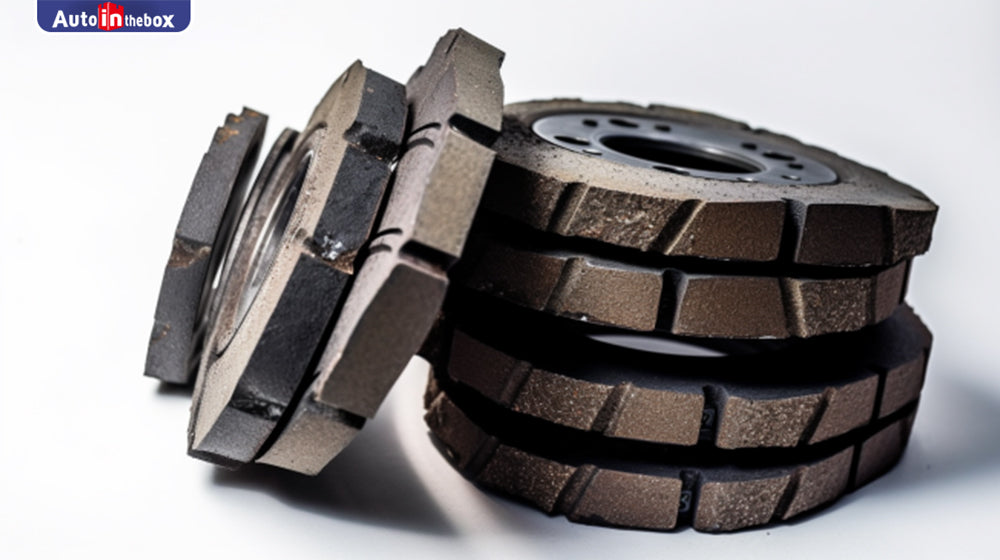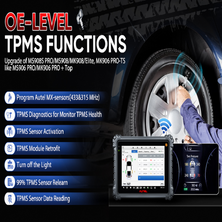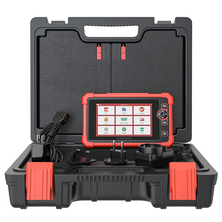
The steering wheel is unstable? How to fix?
The phrase "steering wheel is unstable" refers to a situation where the steering wheel exhibits instability or lack of steady control while driving. It implies that the steering system may have issues causing vibrations, shaking, or difficulty maintaining a straight trajectory. Resolving this problem typically involves inspecting and addressing potential causes such as tire problems, steering system issues, suspension components, and brake system conditions. Seeking professional assistance may be necessary for a thorough diagnosis and appropriate solutions.
Recommended 2023 top car diagnostic tool:Launch X431V+,Launch pros v,Launch pro5,Launch IMMO elite,Launch PADVII
It's important to note that diagnosing the exact cause of an unstable steering wheel may require professional expertise and inspection.
It is crucial to promptly address an unstable steering wheel to ensure safe and comfortable driving conditions. To mitigate these hazards, seeking professional assistance and resolving the underlying causes is essential.
Tire-related Issues: If the instability is due to problems such as improper alignment or worn-out tires, the costs can range from $50 to $200 for alignment adjustments or $200 to $600 for tire replacement, including mounting and balancing.
Steering System Repairs: Repairing components like tie rods, ball joints, or steering linkage can cost anywhere from $200 to $800, depending on the specific parts and labor involved.
Suspension Fixes: Fixing suspension components like shocks, struts, or control arms can range from $300 to $1,200 or more, depending on the extent of the repairs needed and the cost of replacement parts.
Wheel Balancing: Balancing the wheels typically costs around $20 to $100 per wheel, depending on whether it's a standard or high-performance vehicle and whether weights need to be added or removed.
Brake System Maintenance: Addressing brake system issues like warped rotors or worn brake pads can cost between $150 and $600 or more, depending on the extent of the repairs needed and the cost of replacement parts.
Miscellaneous Factors: Additional factors, such as wheel bearings, bushings, or steering column repairs, can introduce additional costs ranging from $100 to $500 or more, depending on the required repairs.
It's essential to remember that these are rough estimates, and the repair costs can vary significantly. It is advisable to consult with a qualified mechanic or repair shop to obtain an accurate assessment of the repairs needed and the associated costs.
Tire-related Fixes:
Tire pressure adjustment or inflation
Tire rotation to ensure even wear
Tire replacement if they are worn out or damaged
Wheel alignment to correct improper tire angles
Steering System Repairs:
Inspection and tightening of loose steering components
Replacement of worn-out or damaged tie rods, ball joints, or steering linkage
Lubrication or adjustment of steering system components
Alignment or calibration of the steering system
Suspension Repairs:
Replacement of worn-out shocks, struts, or control arms
Repair or replacement of damaged or worn suspension components
Suspension system realignment or adjustment
Inspection and tightening of suspension system fasteners
Wheel Balancing:
Balancing the wheels to distribute weight evenly
Adding or removing wheel weights to achieve balance
Inspection for bent or damaged wheels and repair or replacement if necessary
Brake System Maintenance:
Inspection and resurfacing or replacement of warped brake rotors
Replacement of worn brake pads or shoes
Brake system bleeding to remove air and ensure proper function
Repair or replacement of damaged brake components
It is important to note that these repairs may require professional expertise and specialized tools. It is recommended to consult a qualified mechanic or repair shop to diagnose the issue and perform the necessary maintenance accurately. The costs and specific repair methods will vary based on the vehicle make, model, and the extent of the repairs needed.
Regular Maintenance: Follow the manufacturer's recommended maintenance schedule for your vehicle. Regularly inspect and service the steering system, suspension components, tires, and brakes to ensure they are in good working condition.
Tire Maintenance: Maintain proper tire pressure according to the manufacturer's guidelines. Check tire pressure regularly and adjust as needed. Additionally, monitor tire wear and replace tires when they are worn out or damaged. Rotate tires regularly to promote even wear.
Wheel Alignment: Schedule regular wheel alignments to ensure proper alignment of the wheels. Proper alignment helps maintain stability and prevents uneven tire wear.
Suspension System Checks: Regularly inspect the suspension components for signs of wear or damage. Replace worn-out or damaged shocks, struts, control arms, and other suspension parts. Ensure proper lubrication of suspension components.
Brake System Maintenance: Regularly inspect the brake system for signs of wear or damage. Replace worn brake pads, warped rotors, or damaged brake components promptly. Bleed the brake system as recommended to maintain proper function.
Safe Driving Practices:
Practice safe driving habits to minimize stress on the steering system.
Avoid hitting potholes, curbs, and other obstacles that damage suspension or steering components.
Steer smoothly and avoid abrupt steering movements.
Professional Inspections: If you notice any signs of steering wheel instability, such as vibrations or unusual handling, promptly have your vehicle inspected by a qualified mechanic. Early detection and repair of issues can prevent further damage and ensure safe operation.
Following these preventative measures can reduce the likelihood of encountering an unstable steering wheel condition and maintain a safe and comfortable driving experience.
The steering wheel is not just a simple component in a vehicle; it is the vital interface between the driver and the road. Its importance cannot be overstated. Here's why:
In summary, the steering wheel is a functional component and a virtual interface that ensures control, safety, comfort, and an engaging driving experience. Appreciating its significance reinforces maintaining a stable and well-functioning steering wheel for a smooth and enjoyable journey.
Recommended 2023 top car diagnostic tool:Launch X431V+,Launch pros v,Launch pro5,Launch IMMO elite,Launch PADVII
The instability of a steering wheel can be attributed to several possible reasons:
- Tire Issues: Uneven tire pressure, worn-out tires, or improper alignment can result in an unstable steering wheel.
- Steering System Problems: Loose or worn-out steering components, such as tie rods, ball joints, or steering linkage, can cause instability in the steering wheel.
- Suspension Troubles: Faulty or worn-out suspension components, including shocks, struts, or control arms, can lead to a shaky or unstable steering wheel.
- Wheel Balance: Imbalanced wheels, where weight distribution is uneven, can cause vibrations and an unstable steering wheel.
- Brake System Malfunction: Worn-out brake components, such as warped brake rotors or unevenly worn brake pads, can induce vibrations that affect the stability of the steering wheel.
- Other Factors: Additional factors like loose wheel bearings, worn-out bushings, or steering column issues can contribute to an unstable steering wheel.
It's important to note that diagnosing the exact cause of an unstable steering wheel may require professional expertise and inspection.
An unstable steering wheel can pose various risks and hazards while driving:
- Reduced Control: A shaky or unstable steering wheel can make it difficult to maintain precise control over the vehicle, increasing the risk of veering off course or making sudden, erratic steering movements.
- Decreased Stability: The instability of the steering wheel can compromise the vehicle's overall stability, affecting its ability to maintain a straight line and potentially leading to swerving or drifting while driving.
- Impaired Handling: An unstable steering wheel can make it challenging to maneuver the vehicle smoothly, especially during turns or lane changes, potentially affecting the driver's ability to respond quickly and safely to road conditions or obstacles.
- Increased Fatigue: Constantly compensating for an unstable steering wheel can cause driver fatigue and discomfort over long periods of driving. This can negatively impact concentration and reaction times, potentially increasing the likelihood of accidents.
- Vibration and Discomfort: An unstable steering wheel often produces vibrations and shaking, leading to discomfort for the driver and passengers. Prolonged exposure to these vibrations can fatigue and distract, affecting the overall driving experience and concentration.
- Safety Risks: The instability of the steering wheel can compromise the vehicle's overall safety, as it may impact the effectiveness of other safety systems like stability control, traction control, and anti-lock braking systems.
It is crucial to promptly address an unstable steering wheel to ensure safe and comfortable driving conditions. To mitigate these hazards, seeking professional assistance and resolving the underlying causes is essential.
The repair costs associated with an unstable steering wheel can vary depending on the underlying cause and the extent of the required repairs. It's important to note that the following estimates are general and can vary significantly based on factors such as the vehicle make and model, the specific repairs needed, and labor rates in different locations:
Tire-related Issues: If the instability is due to problems such as improper alignment or worn-out tires, the costs can range from $50 to $200 for alignment adjustments or $200 to $600 for tire replacement, including mounting and balancing.
Steering System Repairs: Repairing components like tie rods, ball joints, or steering linkage can cost anywhere from $200 to $800, depending on the specific parts and labor involved.
Suspension Fixes: Fixing suspension components like shocks, struts, or control arms can range from $300 to $1,200 or more, depending on the extent of the repairs needed and the cost of replacement parts.
Wheel Balancing: Balancing the wheels typically costs around $20 to $100 per wheel, depending on whether it's a standard or high-performance vehicle and whether weights need to be added or removed.
Brake System Maintenance: Addressing brake system issues like warped rotors or worn brake pads can cost between $150 and $600 or more, depending on the extent of the repairs needed and the cost of replacement parts.
Miscellaneous Factors: Additional factors, such as wheel bearings, bushings, or steering column repairs, can introduce additional costs ranging from $100 to $500 or more, depending on the required repairs.
It's essential to remember that these are rough estimates, and the repair costs can vary significantly. It is advisable to consult with a qualified mechanic or repair shop to obtain an accurate assessment of the repairs needed and the associated costs.
The specific repairs required to address an unstable steering wheel will depend on the underlying cause. Here are some common repair approaches:
Tire-related Fixes:
Tire pressure adjustment or inflation
Tire rotation to ensure even wear
Tire replacement if they are worn out or damaged
Wheel alignment to correct improper tire angles
Steering System Repairs:
Inspection and tightening of loose steering components
Replacement of worn-out or damaged tie rods, ball joints, or steering linkage
Lubrication or adjustment of steering system components
Alignment or calibration of the steering system
Suspension Repairs:
Replacement of worn-out shocks, struts, or control arms
Repair or replacement of damaged or worn suspension components
Suspension system realignment or adjustment
Inspection and tightening of suspension system fasteners
Wheel Balancing:
Balancing the wheels to distribute weight evenly
Adding or removing wheel weights to achieve balance
Inspection for bent or damaged wheels and repair or replacement if necessary
Brake System Maintenance:
Inspection and resurfacing or replacement of warped brake rotors
Replacement of worn brake pads or shoes
Brake system bleeding to remove air and ensure proper function
Repair or replacement of damaged brake components
It is important to note that these repairs may require professional expertise and specialized tools. It is recommended to consult a qualified mechanic or repair shop to diagnose the issue and perform the necessary maintenance accurately. The costs and specific repair methods will vary based on the vehicle make, model, and the extent of the repairs needed.
To prevent an unstable steering wheel condition, there are several measures you can take:
Regular Maintenance: Follow the manufacturer's recommended maintenance schedule for your vehicle. Regularly inspect and service the steering system, suspension components, tires, and brakes to ensure they are in good working condition.
Tire Maintenance: Maintain proper tire pressure according to the manufacturer's guidelines. Check tire pressure regularly and adjust as needed. Additionally, monitor tire wear and replace tires when they are worn out or damaged. Rotate tires regularly to promote even wear.
Wheel Alignment: Schedule regular wheel alignments to ensure proper alignment of the wheels. Proper alignment helps maintain stability and prevents uneven tire wear.
Suspension System Checks: Regularly inspect the suspension components for signs of wear or damage. Replace worn-out or damaged shocks, struts, control arms, and other suspension parts. Ensure proper lubrication of suspension components.
Brake System Maintenance: Regularly inspect the brake system for signs of wear or damage. Replace worn brake pads, warped rotors, or damaged brake components promptly. Bleed the brake system as recommended to maintain proper function.
Safe Driving Practices:
Practice safe driving habits to minimize stress on the steering system.
Avoid hitting potholes, curbs, and other obstacles that damage suspension or steering components.
Steer smoothly and avoid abrupt steering movements.
Professional Inspections: If you notice any signs of steering wheel instability, such as vibrations or unusual handling, promptly have your vehicle inspected by a qualified mechanic. Early detection and repair of issues can prevent further damage and ensure safe operation.
Following these preventative measures can reduce the likelihood of encountering an unstable steering wheel condition and maintain a safe and comfortable driving experience.
The steering wheel is not just a simple component in a vehicle; it is the vital interface between the driver and the road. Its importance cannot be overstated. Here's why:
- Control: The steering wheel allows the driver to have precise control over the vehicle's direction. It enables the driver to navigate curves, make turns, and maintain a straight path, ensuring safe and accurate maneuvering.
- Safety: A properly functioning steering wheel is crucial for safe driving. It allows the driver to respond quickly to unexpected situations, avoid obstacles, and maintain stability on the road, reducing the risk of accidents.
- Comfort: The steering wheel's design and ergonomics significantly affect driver comfort. It should be comfortable griping and adjustable for different driving positions, minimizing fatigue during long journeys.
- Feedback: The steering wheel provides valuable input to the driver, transmitting information about the road conditions and the vehicle's behavior. This feedback helps the driver make informed decisions and adjustments while driving.
- Driving Experience: The steering wheel contributes to the overall driving experience. A well-designed steering wheel enhances driving pleasure, connecting the driver and the vehicle.
In summary, the steering wheel is a functional component and a virtual interface that ensures control, safety, comfort, and an engaging driving experience. Appreciating its significance reinforces maintaining a stable and well-functioning steering wheel for a smooth and enjoyable journey.
Older Post
 Newer Post
Newer Post

why do shock absorber have oil leaks?

What happens when brake pad wear in the vehicle?










